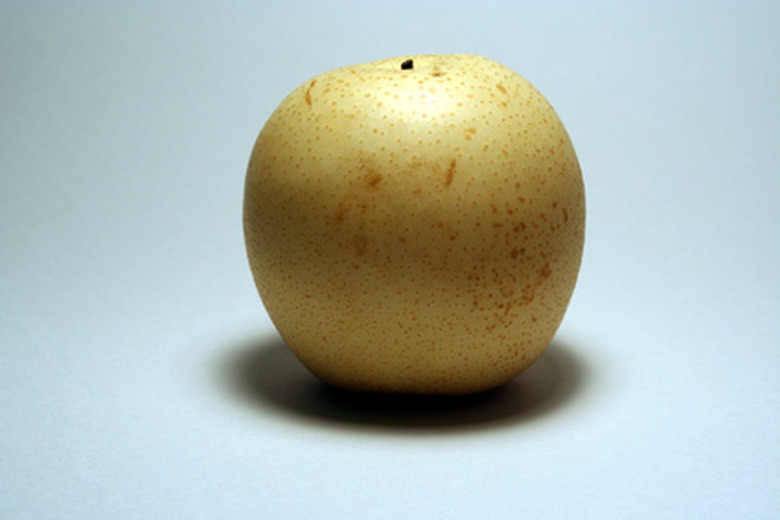Asian Pear Tree Disease
Asian pear trees combine the crisp texture of an apple with the sweet, fragrant flavor of a pear. The trees are native to Asia but grow readily in the United States. Purdue University estimates that 500 acres of Asian pear have been planted annually in California since 1984. Home growers can find many cultivars at a local nursery, including Shinko, Shinseki and Hosui.
Fire Blight
All types of Asian pear except Shinko develop fire blight, which is caused by the Erwinia amylovora bacteria. Affected branches or twigs ooze bacteria in spring. Upon exposure to air the ooze turns dark, staining the tree's bark with brown spots. As they develop, flowers and fruits turn brown or black and wilt or shrivel. The flowers and fruit don't drop off the tree. Severe infections can destroy part or all of the Asian pear tree. To control fire blight, gardeners can apply copper fungicide.
- Asian pear trees combine the crisp texture of an apple with the sweet, fragrant flavor of a pear.
- All types of Asian pear except Shinko develop fire blight, which is caused by the Erwinia amylovora bacteria.
Crown Rot
Trees planted too deep in the soil can contract a Phytophthora crown rot, which will kill the tree over time. There is no treatment for crown rot. Initial symptoms occur underground as the tree's roots rot from excess standing water in the soil. Above ground, the tips or twigs and branches die back. Young trees that develop crown rot may die over a short time period. Older trees will eventually weaken and die. Fungus remains in the soil even after the dead tree is removed, so gardeners should not plant another Asian pear in that location.
- Trees planted too deep in the soil can contract a Phytophthora crown rot, which will kill the tree over time.
Bacterial Canker
During cold, wet springs, any Asian pear tree may develop bacterial canker, caused by the pseudomonas bacteria. Bacterial canker affects both European and Asian pears, with Asian pears experiencing significant wood canker and European pears primarily suffering blossom blight. Bark cankers develop as light brown mottled patches on the bark. With time, affected bark can flake off the tree. Gardeners can prune off affected branches or treat the tree with a fungicide containing streptomycin sulfate.
Prevention
Boost your pear tree's resistance to any disease by regularly pruning the tree to improve air circulation, which helps move bacteria and fungus through the tree. Trees that are regularly fertilized and watered are stronger to begin with, while stressed trees (that aren't watered or fertilized or that don't receive adequate sunlight) may be more prone to disease. Commercial growers apply a preventative streptomycin or copper spray so that trees don't develop fire blight. You can also avoid fire blight by choosing Shinko pears.
- During cold, wet springs, any Asian pear tree may develop bacterial canker, caused by the pseudomonas bacteria.
- Commercial growers apply a preventative streptomycin or copper spray so that trees don't develop fire blight.
International
Asian pear trees outside the United States suffer from different diseases than those in the U.S. These trees can contract black spot in Japan; Purdue University notes that this disease hasn't spread to the United States. Japanese growers bag the developing fruit to ward against the black spot disease, which can't be commercially sold if afflicted. Asian pear trees in Japan also contract scab, albeit a different form of scab than that affecting European pear trees in the United States.
